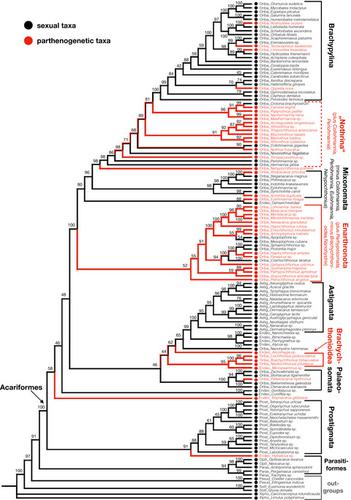当前位置:
X-MOL 学术
›
Ecol. Evol.
›
论文详情
Our official English website, www.x-mol.net, welcomes your
feedback! (Note: you will need to create a separate account there.)
Repeated convergent evolution of parthenogenesis in Acariformes (Acari)
Ecology and Evolution ( IF 2.3 ) Pub Date : 2020-11-20 , DOI: 10.1002/ece3.7047 Patrick Pachl 1 , Matti Uusitalo 2 , Stefan Scheu 1, 3 , Ina Schaefer 1 , Mark Maraun 1
Ecology and Evolution ( IF 2.3 ) Pub Date : 2020-11-20 , DOI: 10.1002/ece3.7047 Patrick Pachl 1 , Matti Uusitalo 2 , Stefan Scheu 1, 3 , Ina Schaefer 1 , Mark Maraun 1
Affiliation

|
The existence of old species‐rich parthenogenetic taxa is a conundrum in evolutionary biology. Such taxa point to ancient parthenogenetic radiations resulting in morphologically distinct species. Ancient parthenogenetic taxa have been proposed to exist in bdelloid rotifers, darwinulid ostracods, and in several taxa of acariform mites (Acariformes, Acari), especially in oribatid mites (Oribatida, Acari). Here, we investigate the diversification of Acariformes and their ancestral mode of reproduction using 18S rRNA. Because parthenogenetic taxa tend to be more frequent in phylogenetically old taxa of Acariformes, we sequenced a wide range of members of this taxon, including early‐derivative taxa of Prostigmata, Astigmata, Endeostigmata, and Oribatida. Ancestral character state reconstruction indicated that (a) Acariformes as well as Oribatida evolved from a sexual ancestor, (b) the primary mode of reproduction during evolution of Acariformes was sexual; however, species‐rich parthenogenetic taxa radiated independently at least four times (in Brachychthonioidea (Oribatida), Enarthronota (Oribatida), and twice in Nothrina (Oribatida), (c) parthenogenesis additionally evolved frequently in species‐poor taxa, for example, Tectocepheus, Oppiella, Rostrozetes, Limnozetes, and Atropacarus, and (d) sexual reproduction likely re‐evolved at least three times from species‐rich parthenogenetic clusters, in Crotonia (Nothrina), in Mesoplophora/Apoplophora (Mesoplophoridae, Enarthronota), and in Sphaerochthonius/Prototritia (Protoplophoridae, Enarthronota). We discuss possible reasons that favored the frequent diversification of parthenogenetic taxa including the continuous long‐term availability of dead organic matter resources as well as generalist feeding of species as indicated by natural variations in stable isotope ratios.
中文翻译:

蜱螨目(Acari)孤雌生殖的重复趋同进化
古老物种丰富的孤雌生殖类群的存在是进化生物学中的一个难题。这些类群指向古代孤雌辐射导致了形态上不同的物种。古代孤雌生殖分类群已被认为存在于蛭形轮虫、达尔文介形虫和螨形螨(螨形目、蜱螨目)的几个分类群中,特别是甲螨类(Oribatida、螨虫)。在这里,我们使用 18S rRNA 研究螨形目的多样化及其祖先的繁殖模式。由于孤雌生殖类群在螨形目的系统发育古老类群中更为常见,因此我们对该类群的广泛成员进行了测序,包括 Prostigmata、Astigmata、Endeostigmata 和 Oribatida 的早期衍生类群。祖先性格状态重建表明,(a)螨形目和甲螨目都是从有性祖先进化而来,(b)螨形目进化过程中的主要繁殖方式是有性繁殖;然而,物种丰富的孤雌生殖类群独立辐射至少四次(在 Brachychthonioidea (Oribatida)、Enarthronota (Oribatida) 中,以及在 Nothrina (Oribatida) 中独立辐射两次,(c) 在物种贫乏的类群中,孤雌生殖也频繁进化,例如Tectocepheus 、 Oppiella 、 Rostrozetes 、 Limnozetes和Atropacarus ,以及(d)有性繁殖可能从物种丰富的孤雌生殖集群中进化了至少三次,在Crotonia (Nothrina)、 Mesoplophora/Apoplophora (Mesoplophoridae、Enarthronota) 和Sphaerochthonius中/ Prototritia (Protoplophoridae, Enarthronota)。 我们讨论了有利于孤雌生殖类群频繁多样化的可能原因,包括死亡有机物资源的持续长期可用性以及稳定同位素比率自然变化所表明的物种普遍进食。
更新日期:2021-01-08
中文翻译:

蜱螨目(Acari)孤雌生殖的重复趋同进化
古老物种丰富的孤雌生殖类群的存在是进化生物学中的一个难题。这些类群指向古代孤雌辐射导致了形态上不同的物种。古代孤雌生殖分类群已被认为存在于蛭形轮虫、达尔文介形虫和螨形螨(螨形目、蜱螨目)的几个分类群中,特别是甲螨类(Oribatida、螨虫)。在这里,我们使用 18S rRNA 研究螨形目的多样化及其祖先的繁殖模式。由于孤雌生殖类群在螨形目的系统发育古老类群中更为常见,因此我们对该类群的广泛成员进行了测序,包括 Prostigmata、Astigmata、Endeostigmata 和 Oribatida 的早期衍生类群。祖先性格状态重建表明,(a)螨形目和甲螨目都是从有性祖先进化而来,(b)螨形目进化过程中的主要繁殖方式是有性繁殖;然而,物种丰富的孤雌生殖类群独立辐射至少四次(在 Brachychthonioidea (Oribatida)、Enarthronota (Oribatida) 中,以及在 Nothrina (Oribatida) 中独立辐射两次,(c) 在物种贫乏的类群中,孤雌生殖也频繁进化,例如Tectocepheus 、 Oppiella 、 Rostrozetes 、 Limnozetes和Atropacarus ,以及(d)有性繁殖可能从物种丰富的孤雌生殖集群中进化了至少三次,在Crotonia (Nothrina)、 Mesoplophora/Apoplophora (Mesoplophoridae、Enarthronota) 和Sphaerochthonius中/ Prototritia (Protoplophoridae, Enarthronota)。 我们讨论了有利于孤雌生殖类群频繁多样化的可能原因,包括死亡有机物资源的持续长期可用性以及稳定同位素比率自然变化所表明的物种普遍进食。









































 京公网安备 11010802027423号
京公网安备 11010802027423号